#autonomous spaceport drone ship
Link
Following several launch delays last week, the week of Aug. 21 through Aug. 27 is set to see seven launches marking the 129th through 135th orbital launch attempts of 2023. Starting the week off, SpaceX will launch two back-to-back Starlink missions from Space Launch Complex (SLC) 4 East at the Vandenberg Space Force Base (VSFB) and from SLC-40 at the Cape Canaveral Space Force Station (CCSFS). Next, Russia will launch its Progress resupply mission, followed by Rocket Lab’s launch of “We Love the Nightlife.” SpaceX will then launch the Crew-7 mission from Launch Complex 39A (LC-39A); JAXA will launch the SLIM and XRISM mission; SpaceX will end the week off with the O3b mPOWER 5 and 6 mission from SLC-40. Falcon 9 Block 5 | Starlink Group 7-1 Starting the week off, SpaceX is expected to launch another Starlink mission on Monday, Aug. 21 at 11:04 PM PDT (06:04 UTC on Aug. 22). The launch has suffered a three-day delay due to Hurricane Hilary, which has developed in the northeast waters of the Pacific Ocean, impacting recovery operations for the mission. This mission, dubbed Starlink Group 7-1, will be the first Group 7 launch. Falcon 9 will lift off from SLC-4E at the VSFB and place 21 Starlink v2 Mini satellites into a 286 by 296-kilometer orbit at 53.05 degrees. The booster, B1061-15, has supported two crewed missions (Crew-1 and Crew-2), SXM-8, CRS-23, IXPE, two transporter missions, Globalstar FM15, EROS-C3, and five Starlink missions. Following the launch, the booster will land on SpaceX’s autonomous spaceport drone ship (ASDS) Of Course I Still Love You, which was tugged over 600 kilometers downrange by Scorpius. Similar to Bob and Doug, GO Beyond will provide ASDS support and recover both fairings from the pacific ocean. This mission will mark SpaceX’s 49th launch from SLC-4E, 58th launch of 2023, 218th landing, 144th consecutive landing, 189th re-flight of a booster, and 248th Falcon 9 launch. Falcon 9 Block 5 | Starlink Group 6-11 After being delayed a day, SpaceX’s second Starlink launch of the week will launch another 22 Starlink v2 Mini satellites to low-Earth orbit on the Starlink Group 6-11 mission. Launching from SLC-40 at the CCSFS once again, this launch will bring the total number of Starlink satellites launched to 5,005, of which ~4,660 should still be in orbit. Additionally, 4,566 of these are currently in their operational orbits. Streak shot of B1069-9 launching on Starlink Group 6-9. (Credit: Max Evans for NSF) Liftoff is expected to occur on Tuesday, Aug. 22, at 8:47 PM EDT (00:47 UTC on Aug. 23), and will mark SpaceX’s 250th Falcon 9 mission (SpaceX’s pre-flight anomaly AMOS-6 counts as a Falcon 9 mission, but not launch; hence there being one more launch than mission). Following liftoff, the currently unknown booster will also complete a two-burn profile, landing on SpaceX’s ASDS Just Read the Instructions. The initial orbit is currently unknown but is expected to be a near 300-kilometer circular orbit inclined 43.00 degrees. The satellites will then spend the coming months raising their orbits to the Group 6 orbit — a 530-kilometer circular orbit inclined 43 degrees. Soyuz 2.1a | Progress MS-24 Progress MS-24 is set to launch atop the Soyuz 2.1a rocket and deliver cargo and supplies to the International Space Station (ISS). The launch is scheduled for Aug. 23, 2023, 01:08 UTC from Site 31/6 at the Baikonur Cosmodrome in Kazakhstan. The spacecraft will autonomously dock with the Station on Aug. 21 at a currently unknown time. The spacecraft supporting this mission, designated 85P, is the 24th Progress-M spacecraft and masses 7.3 tonnes and can carry up to 2.5 tonnes of cargo, including propellant, water, food, equipment, and experiments to the ISS. Progress will remain docked to the Station for around six months; during this time it will provide support services, such as attitude control, orbit correction, and refueling. After its stay is complete, the spacecraft will undock from the ISS and perform a de-orbit burn. Unlike Soyuz and Dragon, the Progress spacecraft does not have a heatshield and will burn up in Earth’s atmosphere. Electron | We Love the Nightlife After signing a deal with Rocket Lab in February of this year, the company will launch its first mission for Capella Space’s Acadia satellite constellation. Following an aborted launch attempt on July 30 due to low igniter pressure in an engine, then several other launch delays, the Electron is still waiting to lift off from Launch Complex 1B, at the Mahiah Peninsula, in New Zealand. The launch is currently scheduled for Aug. 23, at 23:30 UTC. Launch update We are standing down from today’s launch attempt due to out-of-family sensor data. The team will review and we’ll be back to the pad soon. Stay tuned for updates! pic.twitter.com/RaQ6inbkkv — Rocket Lab (@RocketLab) August 6, 2023 Electron will place the single satellite into a 640-kilometer circular mid-inclination orbit in what will be the first of four launches by Rocket Lab for the Acadia synthetic aperture radar (SAR) constellation — an Earth-imaging constellation slated to offer increased imaging capability and better communications connectivity for customers. These satellites are designed, manufactured, and operated by Capella Space. Falcon 9 Block 5 | SpaceX Crew-7 Following the completion of its original Commercial Crew Transportation Capabilities contract, SpaceX will launch the first of three extension missions, dubbed Crew-7. The mission will lift off from LC-39A on Aug. 25, at 3:49 AM EDT (07:49 UTC) where it will spend roughly a day raising its orbit before docking with the ISS on Sunday, Aug. 26, at 2:02 AM EDT (06:02 UTC). Aboard Crew Dragon C210-3 Endurance is spacecraft commander Jasmin Moghbeli of NASA, pilot Andreas Mogensen from ESA, and mission specialists Satoshi Furukawa of JAXA and Konstantin Borisov of Roscosmos. This will mark the first time that four different space agencies are represented on a single Crew Dragon flight. The crew will join the Expedition 69/70 crew on the ISS and conduct various experiments and maintenance tasks. Endurance and its crew will remain on Station for approximately 190 days, until early 2024 when the Crew-8 crew arrives at the ISS. They will then return to Earth in Endurance and be recovered by Shannon or Megan. Crew-7’s Dragon arrived at Pad 39A in Florida ahead of its third mission to the @space_station. As teams prepare to launch Crew-7 and safely bring Crew-6 home, the Crew-8 astronauts completed their first week of training in California pic.twitter.com/BpEc6k6ZSj — SpaceX (@SpaceX) August 17, 2023 The booster supporting this mission is brand new: B1081-1 and will be the newest booster in SpaceX’s fleet. Following its ascent, the booster will perform three burns. First, the booster will use its center E9 engine and outer E1 and E5 engines to perform a boost backburn. Next up, the center engine will ignite again for the booster’s reentry burn. Finally, the center engine, followed by the same two outer engines briefly, will ignite, bringing the booster to a soft landing on SpaceX’s Landing Zone 1. This will mark the first return to launch site mission on a NASA Commercial Crew flight, the 220th booster landing, and the 146th consecutive landing. H-IIA 202 | SLIM & XRISM JAXA is set to launch the smart lander for investigating the moon (SLIM) and X-ray imaging and spectroscopy mission (XRISM) atop the H-IIA 202 rocket on Aug. 26, at 00:34 UTC. The mission will lift off from LA-Y1 at the Tanegashima Space Center, in Japan and mark the JAXA’s first mission of 2023. SLIM will be Japan’s first lunar surface mission and will demonstrate the ability to precisely land on the surface. During its descent, it will utilize data collected by JAXA’s SELENE lunar orbiter mission to land within 100 meters of a target. The lander will explore the lunar surface near the Marius Hills Hole, a possible entrance to a lava tube. H-IIA will place this spacecraft into a trans-lunar injection. The H-IIA rocket lifting off from Tanegashima. (Credit: JAXA) XRISM is a joint NASA and ESA mission that aims to study the structure of the universe, outflows of galaxy nuclei, and dark matter. Onboard are a pair of instruments: Resolve is a soft X-ray spectrometer that uses a lightweight X-ray mirror and microcalorimeter to detect energy and intensity of X-rays with an accuracy of 5-7 eV in the .3-12 keV range. The second instrument is Xtend, a sift X-ray imager that uses four CCD detectors and an identical X-ray mirror to cover a large field of view of 38 arc minutes on a side in the .4-13 keV range. This will enable detailed studies of the physics and chemistry of various cosmic phenomena, such as black holes, galaxy clusters, supernova remnants, and more. The satellite will be operated from low-Earth orbit. Falcon 9 Block 5 | O3b mPOWER 5 & 6 Ending this busy week will be another Falcon 9 launch from SLC-40. A currently unknown booster is set to place a pair of 1,700-kilogram satellites into a medium-Earth orbit. Liftoff is scheduled for Aug. 27 at 7:04 EDT (22:04 UTC). The O3b mPOWER constellation is a constellation of 11 communication satellites that provide high-speed, low-latency broadband connectivity to remote and underserved areas of the world. The satellites are owned and operated by SES. Following the launch, the first stage will land on A Shortfall of Gravitas, which will be stationed over 600 kilometers downrange. The fairing halves will be recovered by Doug. (Lead image: Crew Dragon Endurance ahead of the Crew-7 mission. Credit: SpaceX) The post Launch Roundup: SpaceX to launch four missions, Progress MS-24 to resupply ISS appeared first on NASASpaceFlight.com.
0 notes
Text
'A Shortfall of Gravitas' arrives in Port Canaveral
#SpaceX's newest rocket-catching drone ship, "A Shortfall of Gravitas," is now in Port Canaveral being readied for its first missions. #ASOG #Falcon9
SpaceX’s drone ship “A Shortfall of Gravitas” in Port Canaveral, Florida. Credit: Theresa Cross / Spaceflight Insider
On July 15, SpaceX’s newest drone ship, “A Shortfall of Gravitas,” made its way into Port Canaveral on Florida’s Space Coast. (more…)

View On WordPress
#A Shortfall of Gravitas#Autonomous Spaceport Drone Ship#Falcon 9#Just Read the Instructions#Lead Stories#Of Course I Still Love You#Port Canaveral#SpaceX
2 notes
·
View notes
Photo

SpaceX’s autonomous spaceport drone ship - Of course I still love you..
#SpaceX#Space X#drone ship#Of course I still love you#sea#engineering#ocean#autonomous spaceport drone ship#spaceport#spaceport drone ship#autonomous drone ship#autonomous spaceport
12 notes
·
View notes
Photo

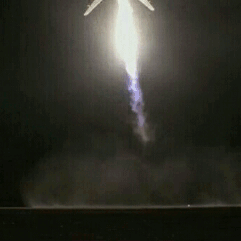



Made some SpaceX landings into gifs. First two are Orbcomm OG2 Flight 2, third is JSCAT-14, and last two are SES-10.
#spacex#nasa#space#space x#falcon9#falcon 9#landing#lz1#landingzone1#ofcourseistillloveyou#of course i still love you#asds#autonomous spaceport drone ship#rocket#rockets#launch
2 notes
·
View notes
Text
SpaceX Successfully Launches First of Seven Iridium NEXT Multi-Satellite Missions
SpaceX Successfully Launches First of Seven Iridium NEXT Multi-Satellite Missions
As well as returning SpaceX to flight, today’s mission marked the first successful drone ship landing for Just Read the Instructions. Photo Credit: SpaceX/Twitter SpaceX has returned to flight operations, with the successful delivery of ten Iridium NEXT global mobile telecommunications satellites to low-Earth orbit. Launch of the Upgraded Falcon 9 took place during an “instantaneous” window at…
View On WordPress
#aerospace#AmericaSpace#AMOS-6#ASDS#Autonomous Spaceport Drone Ship#Commercial#Falcon 9#Iridium NEXT#Merlin-1D#rocket#Rockets#SLC-4E#Space#spacecraft#spaceflight#SpaceX#Upgraded Falcon 9#Vandenberg Air Force Base
2 notes
·
View notes
Photo
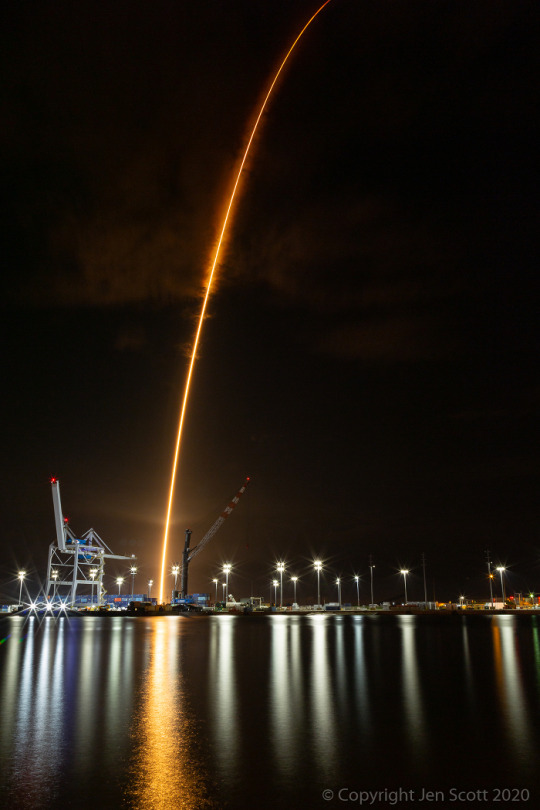
Crew 1 Mission Launch Streak : Leaving planet Earth for a moment, a SpaceX Falcon 9 rocket arced into the early evening sky last Sunday at 7:27 pm EST. This 3 minute 20 second exposure traces the launch streak over Kennedy Space Center's Launch Complex 39A. The rocket carried four astronauts en route to the International Space Station on the first flight of a NASA-certified commercial human spacecraft system. Dubbed Resilience, the astronauts' Crew Dragon spacecraft successfully docked with the orbital outpost one day later, on Monday, November 16. At the conclusion of their six-month stay on the ISS, the Crew-1 astronauts will use their spacecraft return to Earth. Of course about 9 minutes after launch the Falcon 9 rocket's first stage returned to Earth, landing in the Atlantic Ocean on autonomous spaceport drone ship Just Read The Instructions. via NASA
368 notes
·
View notes
Photo

2020 November 19
Crew-1 Mission Launch Streak
Image Credit & Copyright: Jen Scott
Explanation: Leaving planet Earth for a moment, a SpaceX Falcon 9 rocket arced into the early evening sky last Sunday at 7:27 pm EST. This 3 minute 20 second exposure traces the launch streak over Kennedy Space Center's Launch Complex 39A. The rocket carried four astronauts en route to the International Space Station on the first flight of a NASA-certified commercial human spacecraft system. Dubbed Resilience, the astronauts' Crew Dragon spacecraft successfully docked with the orbital outpost one day later, on Monday, November 16. At the conclusion of their six-month stay on the ISS, the Crew-1 astronauts will use their spacecraft return to Earth. Of course about 9 minutes after launch the Falcon 9 rocket's first stage returned to Earth, landing in the Atlantic Ocean on autonomous spaceport drone ship Just Read The Instructions.
∞ Source: apod.nasa.gov/apod/ap201119.html
40 notes
·
View notes
Photo
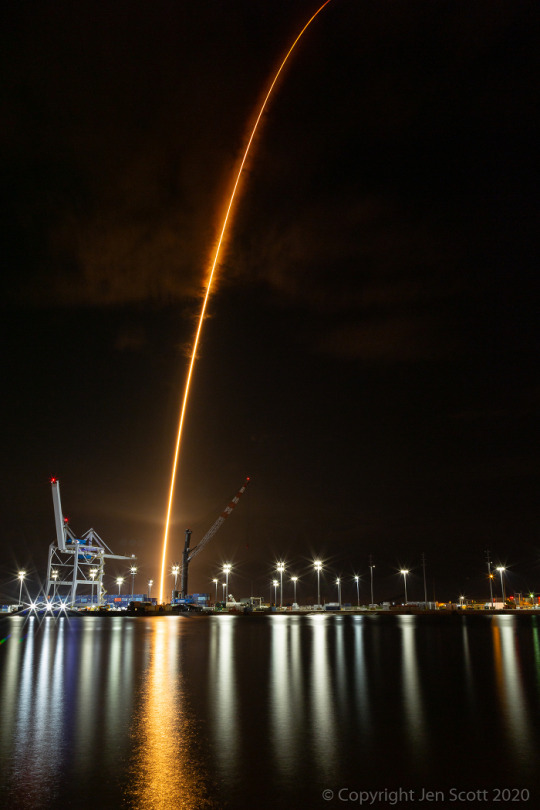
Crew 1 Mission Launch Streak via NASA https://ift.tt/3nFLtZo
Leaving planet Earth for a moment, a SpaceX Falcon 9 rocket arced into the early evening sky last Sunday at 7:27 pm EST. This 3 minute 20 second exposure traces the launch streak over Kennedy Space Center's Launch Complex 39A. The rocket carried four astronauts en route to the International Space Station on the first flight of a NASA-certified commercial human spacecraft system. Dubbed Resilience, the astronauts' Crew Dragon spacecraft successfully docked with the orbital outpost one day later, on Monday, November 16. At the conclusion of their six-month stay on the ISS, the Crew-1 astronauts will use their spacecraft return to Earth. Of course about 9 minutes after launch the Falcon 9 rocket's first stage returned to Earth, landing in the Atlantic Ocean on autonomous spaceport drone ship Just Read The Instructions.
(Published November 19, 2020)
12 notes
·
View notes
Photo

Crew 1 Mission Launch Streak
Leaving planet Earth for a moment, a SpaceX Falcon 9 rocket arced into the early evening sky last Sunday at 7:27 pm EST. This 3 minute 20 second exposure traces the launch streak over Kennedy Space Center's Launch Complex 39A. The rocket carried four astronauts en route to the International Space Station on the first flight of a NASA-certified commercial human spacecraft system. Dubbed Resilience, the astronauts' Crew Dragon spacecraft successfully docked with the orbital outpost one day later, on Monday, November 16. At the conclusion of their six-month stay on the ISS, the Crew-1 astronauts will use their spacecraft return to Earth. Of course about 9 minutes after launch the Falcon 9 rocket's first stage returned to Earth, landing in the Atlantic Ocean on autonomous spaceport drone ship Just Read The Instructions.
November 19, 2020
via Space https://ift.tt/3nFLtZo
8 notes
·
View notes
Photo

Falcon 9 first-stage on an autonomous spaceport drone ship, after the first successfully landing of an orbital rocket's first stage on a floating ocean platform
via reddit
52 notes
·
View notes
Photo
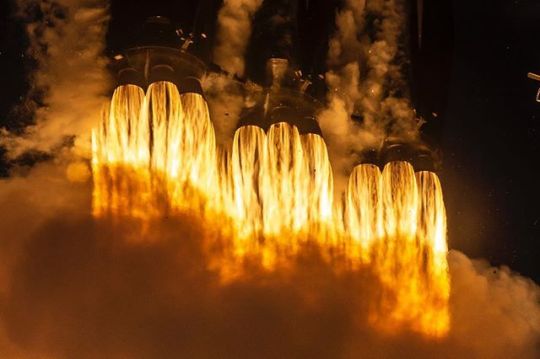
APOD: 2019 April 20 - Falcon Heavy Launch Close Up . Image Credit: SpaceX . Explanation: Twenty seven Merlin rocket engines are firing in this close-up of the launch of a Falcon Heavy rocket. Derived from three Falcon 9 first stage rockets with nine Merlin rocket engines each, the Falcon Heavy left NASA's Kennedy Space Center launch pad 39A on April 11. This second launch of a Falcon Heavy rocket carried the Arabsat 6A communications satellite to space. In February of 2018, the first Falcon Heavy launch carried Starman and a Tesla Roadster. Designed to be reusable, both booster stages and the central core returned safely to planet Earth, the boosters to Cape Canaveral Air Force Station landing zones. The core stage landed off shore on autonomous spaceport drone ship Of Course I Still Love You. via Instagram http://bit.ly/2VjcYxK
10 notes
·
View notes
Link
Following a plethora of launches last week, the week of Aug. 14 through Aug. 20 is set to have four orbital launches—most of which are SpaceX Starlink launches. The week started with the China Aerospace Science and Industry Corporation (CASIC) launching the HEAD-3A/B/C/D/E satellites atop its Kuaxzhou 1A rocket. After that, SpaceX will launch three back-to-back Starlink missions, starting with Starlink Group 6-10 from Space Launch Complex (SLC) 40 at the Cape Canaveral Space Force Station (CCSFS), followed by Group 7-1 from SLC-4 East at the Vandenberg Space Force Base (VSFB) in California. Finally, the Starlink Group 6-11 mission will end the week, launching from SLC-40. These missions mark the 126th through 129th orbital launch attempts of 2023 — a cadence that, if kept up, will lead to over 200 orbital launches this year. Additionally, if SpaceX’s cadence continues to grow at the same rate, the company is on track to launch just under 100 times in 2023. Kuaizhou 1A | HEAD-3A/B/C/D/E On Monday, Aug. 14, the CASIC successfully launched five commercial ship/traffic automatic identification system tracking satellites. Launching at 05:32 UTC from the mobile launcher pad at the Xichang Satellite Launch Center in China, the vehicle placed the payloads into a 694 by 704-kilometer orbit inclined 45.00 degrees. These microsatellites will be used by the Chinese government to track and monitor ships and commercial vehicles, allowing for tracking of goods across the area. This launch marked the 22nd launch of Kuaizhou 1A and the fourth of 2023. Video (via CASIC): pic.twitter.com/r9KCkz5bxA — Cosmic Penguin (@Cosmic_Penguin) August 14, 2023 Falcon 9 Block 5 | Starlink Group 6-10 SpaceX’s first Starlink mission of the week will take place on Wednesday, Aug. 16 at 8:14 PM EDT (00:14 UTC on Aug. 17) from SLC-40 at the CCSFS in Florida. This mission will launch 22 Starlink v2 Mini satellites into a 284 by 294-kilometer orbit inclined 43.00 degrees. To get there, Falcon 9 will utilize its standard two-burn profile, with payloads deploying one hour and six minutes after liftoff. The booster supporting this mission is B1067-13, which has previously supported CRS-22, Crew-3, Turksat 5B, Crew-4, CRS-25, Hotbird 13G, O3b mPOWER 1&2, Satria, and four Starlink missions. This will mark the 180th Falcon 9 flight with a flight-proven booster. However, following liftoff, the first stage will conduct the usual two-burn profile to land on SpaceX’s autonomous spaceport droneship (ASDS) A Shortfall of Gravitas, which was tugged ~640 kilometers downrange by Doug. Following a reduction in fleet size, SpaceX utilizes Doug for ASDS support, tugging, and fairing recovery — reducing the need from four marine assets per launch to two or three. The Coast Guard mandates that a ship must be near the ASDS, disallowing the drone ship to be on its own while Bob or Doug recover fairings. Because of this, and SpaceX’s high launch cadence, SpaceX sends out a third boat that generally swaps between missions to fulfill the Coast Guard’s mandates. As noted, Doug will attempt fairing recovery on this mission ~670 kilometers downrange. While it is currently unknown if the fairings on this mission are flight-proven or not, they will most likely be flight-proven, as over 92% of SpaceX launches this year have reused at least one fairing half. Departure! ASOG and Doug are outbound from Florida to support Starlink 6-10. JRTI inbound next from 6-9. 24/7 stream: https://t.co/icguJj64A8 pic.twitter.com/EGylMh9hCO — Gav Cornwell (@SpaceOffshore) August 13, 2023 SpaceX and the 45th Space Wing will be watching the weather closely, with the weather only 20% go for launch at the start of the window and 65% go at the end. In the event of a delay, SpaceX has three backup T0s and another launch window 24 hours later. Falcon 9 Block 5 | Starlink Group 7-1 SpaceX is expected to launch another Starlink mission on Thursday, Aug. 17 at ~12:00 AM PDT (07:00 UTC). This mission, dubbed Starlink Group 7-1, will be the first Group 7 launch. Falcon 9 will lift off from SLC-4E at the VSFB and place 21 Starlink v2 Mini satellites into a 286 by 296-kilometer orbit at 53.05 degrees. The booster, B1061-15, has supported two crewed missions — Crew-1 and Crew-2 — SXM-8, CRS-23, IXPE, two transporter missions, Globalstar FM15, EROS-C3, and five Starlink missions. Following the launch, the booster will land on SpaceX’s ASDS Of Course I Still Love You, which was tugged over 600 kilometers downrange by Scorpius. Similar to Bob and Doug, GO Beyond will provide ASDS support and recover both fairings from the pacific ocean. This mission will mark SpaceX’s 49th launch from SLC-4E, 58th launch of 2023, 218th landing, 144th consecutive landing, 189th re-flight of a booster, and 248th Falcon 9 launch. Falcon 9 Block 5 | Starlink Group 6-11 Ending the week, SpaceX will launch another 22 Starlink v2 Mini satellites to low-Earth orbit on the Starlink Group 6-11 mission. Launching from SLC-40 at the CCSFS once again, this launch will bring the total number of Starlink satellites launched to 5,005, of which ~4,660 should still be in orbit. Additionally, 4,566 of these are currently in their operational orbits. Streak shot of B1069-9 launching on Starlink Group 6-9. (Credit: Max Evans for NSF) Liftoff is expected to occur on Sunday, Aug. 20, at 8:32 PM EDT (00:32 UTC on Aug. 21), and will mark SpaceX’s 250th Falcon 9 mission (SpaceX’s pre-flight anomaly AMOS-6 counts as a Falcon 9 mission, but not launch; hence there being one more launch than mission). Following liftoff, the currently unknown booster will also complete a two-burn profile, landing on SpaceX’s ASDS Just Read the Instructions. The initial orbit is currently unknown but is expected to be a near 300-kilometer circular orbit inclined 43.00 degrees. The satellites will then spend the coming months raising their orbits to the Group 6 orbit — a 530-kilometer circular orbit inclined 43 degrees. (Lead image: B1077 and B1063 at port preparing for transport to the refurbishment hangar. Credit: Julia Bergeron for NSF) The post Launch Roundup: three back-to-back Starlink missions to cross 5,000 Starlink satellites launched appeared first on NASASpaceFlight.com.
0 notes
Text
'A Shortfall of Gravitas' added to SpaceX's rocket recovery fleet
'A Shortfall of Gravitas' will soon join SpaceX's Space Coast recovery fleet. #ASOG #Falcon9
The drone ship “A Shortfall of Gravitas” begins sea trials before heading to Cape Canaveral to begin catching Falcon 9 first stage boosters. Credit: SpaceX
SpaceX is adding a third autonomous spaceport drone ship to its fleet. “A Shortfall of Gravitas” has left Port Fourchon, Louisiana, to begin sea trials before heading to the Space Coast. (more…)

View On WordPress
#A Shortfall of Gravitas#Autonomous Spaceport Drone Ship#Cape Canaveral#Falcon 9#Falcon Heavy#Lead Stories#space coast#SpaceX
0 notes
Link
For just $6.99 Inspired (although not officially endorsed) by everyone's second favorite autonomous spaceport drone ship. SpaceX's "Just Read The Instructions" Includes filter pocket, can be used with or without. Breathable, keeps out the badness (maybe? who really knows at this point) 97% Cotton, 3% Spandex for a soft comfortable fit. Screen printed design, not cheap computer transfer One size fits most
0 notes
Text
SpaceX Ready for Return-to-Flight Mission, Launching 10-Strong Iridium NEXT Payload
SpaceX Ready for Return-to-Flight Mission, Launching 10-Strong Iridium NEXT Payload
The Upgraded Falcon 9 vehicle for the first Iridium NEXT mission is prepared for launch. Photo Credit: SpaceX/Matt Desch/Twitter Four months after an Upgraded Falcon 9 booster catastrophically exploded on Space Launch Complex (SLC)-40 at Cape Canaveral Air Force Station, Fla.—destroying both the vehicle and its payload, the Amos-6 communications satellite—SpaceX is ready for its second…
View On WordPress
#aerospace#AmericaSpace#AMOS-6#ASDS#Autonomous Spaceport Drone Ship#Commercial#Iridium NEXT#Just Read The Instructions#LEO#Low Earth Orbit#Merlin-1D#rocket#Rockets#SLC-4E#Space#spacecraft#spaceflight#SpaceX#Upgraded Falcon 9#Vandenberg Air Force Base
2 notes
·
View notes
Photo
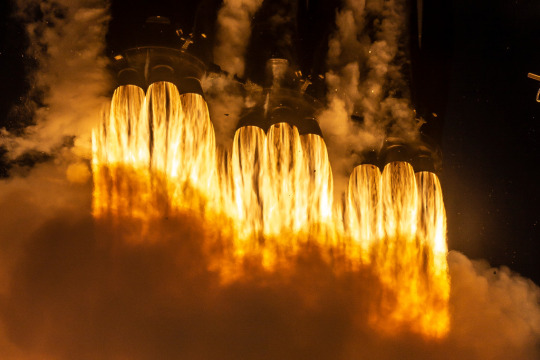
Falcon Heavy Launch Close up : Twenty seven Merlin rocket engines are firing in this close-up of the launch of a Falcon Heavy rocket. Derived from three Falcon 9 first stage rockets with nine Merlin rocket engines each, the Falcon Heavy left NASA's Kennedy Space Center launch pad 39A on April 11. This second launch of a Falcon Heavy rocket carried the Arabsat 6A communications satellite to space. In February of 2018, the first Falcon Heavy launch carried Starman and a Tesla Roadster. Designed to be reusable, both booster stages and the central core returned safely to planet Earth, the boosters to Cape Canaveral Air Force Station landing zones. The core stage landed off shore on autonomous spaceport drone ship Of Course I Still Love You. via NASA
401 notes
·
View notes